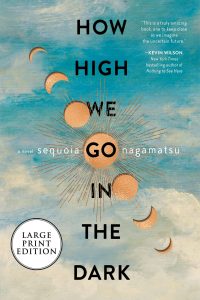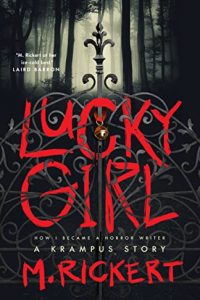Gabino Iglesias Reviews How High We Go in the Dark by Sequoia Nagamatsu
 How High We Go in the Dark, Sequoia Nagamatsu (Morrow 978-0063072640, $27.99, 304pp, hc) January 2022.
How High We Go in the Dark, Sequoia Nagamatsu (Morrow 978-0063072640, $27.99, 304pp, hc) January 2022.
Reading Sequoia Nagamatsu’s How High We Go in the Dark is not always a pleasurable experience. Emotionally gritty, uncomfortably plausible, and incredibly timely, this novel is packed with pain, grief, loss, and the kind of possibilities that make you want to forget how much you don’t know about the future. However, it’s also a book you can’t put down once you start reading, because the poetry of pain and the strength of the characters inhabiting its pages pull you in and make it impossible to not share their feelings, to not join them in that brief moment of their lives we’re being shown.
How High We Go in the Dark is a mosaic novel that follows different characters as they cope with the immediate and then the lingering aftermath of a deadly pandemic caused by an ancient virus brought back after being found in the preserved body of a girl who was found by a research team in the Arctic Circle. Initially affecting mostly children, the virus mutates human organs and inevitably leads to death. For generations, humans rush to find ways to prolong life and to deal with the dead and the pain and suffering their passing leaves behind. The grieving father of a woman who died at the Batagaika Crater, where the body of the girl was found and the virus brought back; a man working at a theme park designed to deliver a last day of joy before euthanizing children; a mother and her dying child looking for a way to beat the virus; a doctor who struggled to keep his kid alive and ended up dealing with a pig who can communicate with humans in the process; a bereavement coordinator learning to cope with his own family drama and his estranged mother’s illness; a woman who used to solve murders and switched her focus to the plague; and a Japanese man – a ‘‘lucky’’ survivor – who lives in a tiny personal pod in a virtual café in Tokyo; all these are just some of the characters that bring this narrative to life.
Writing about grief in a powerful way is no easy task, but Nagamatsu makes it look easy here. The pages of this novel are packed with people who have lost someone and/or are helping others deal with their loss, and the array of feelings they experience radiates off the pages and right into the readers’ hearts. This is a narrative about humanity struggling to survive, fighting to hold on to those they love for one more day, and people dealing with untimely death, but it’s also a story that celebrates the small things: finding someone and spending time together for a while, doing something nice for someone who needs it, or sacrificing our desires to put someone else’s before our own. A horrible plague easily pushes the worst people have to offer to the forefront because pain and anger change us, but it can also change us in good ways and remind us of the things that matter most, and Nagamatsu writes about both things while somehow finding a perfect balance between the light and the dark.
How High We Go in the Dark fully engages with science fiction. From organ transplants and robo-dogs to new social media and NASA taking ‘‘the first step for humanity to become part of whatever is beyond our solar system,’’ Nagamatsu’s love for the genre is ever-present. However, it’s the novel’s emotional depth that makes this a memorable read. Also, the writing itself – at once poetic and brutal – makes this one of the best debuts I’ve read in a while. There’s a character trapped in a strange, dark reality along with others (they climb in the dark!), and they witness strange luminous orbs and see memories inside them. This leads to beautiful passages, including this one, which also shows how this narrative possesses a sense of cohesion despite the many characters, places, and times it juggles:
Of course, some orbs seem to lack any explanation at all – a silver pod the size of a coffin darting across our solar system, crashing into the ocean; a large iridescent planet like the interior of an abalone shell orbiting three stars; a woman in a cave wearing animal skins and crying over the body of a little girl. We watch this cave woman sing in unknown languages, place flower petals over the girl’s eyes. We watch her walk across a vast plain as she sheds her clothing and turns into light.
How High We Go in the Dark is about many things – anger, loss, desperation, mourning – but it’s also about the importance of memory, and that, ironically, is one of the book’s most memorable elements. We all die, but we live on in those who remember us, who recall the things we went through and accomplished, and that truth shines in this story.
How High We Go in the Dark is a superb, wildly imaginative, and prescient debut from an author whose short stories have already shown the world what he is capable of. This marks the arrival of an exciting new voice in science fiction; an author whose amazing imagination is as big as his heart.
Gabino Iglesias is a writer, journalist, professor, and book reviewer living in Austin TX. He is the author of Zero Saints and Coyote Songs and the editor of Both Sides. His work has been nominated to the Bram Stoker and Locus Awards and won the Wonderland Book Award for Best Novel in 2019. His short stories have appeared in a plethora of anthologies and his non-fiction has appeared in the New York Times, the Los Angeles Times, and CrimeReads. His work has been published in five languages, optioned for film, and praised by authors as diverse as Roxane Gay, David Joy, Jerry Stahl, and Meg Gardiner. His reviews appear regularly in places like NPR, Publishers Weekly, the San Francisco Chronicle, Criminal Element, Mystery Tribune, Vol. 1 Brooklyn, the Los Angeles Review of Books, and other print and online venues. He’s been a juror for the Shirley Jackson Awards twice and has judged the PANK Big Book Contest, the Splatterpunk Awards, and the Newfound Prose Prize. He teaches creative writing at Southern New Hampshire University’s online MFA program. You can find him on Twitter at @Gabino_Iglesias.
This review and more like it in the January 2022 issue of Locus.
 While you are here, please take a moment to support Locus with a one-time or recurring donation. We rely on reader donations to keep the magazine and site going, and would like to keep the site paywall free, but WE NEED YOUR FINANCIAL SUPPORT to continue quality coverage of the science fiction and fantasy field.
While you are here, please take a moment to support Locus with a one-time or recurring donation. We rely on reader donations to keep the magazine and site going, and would like to keep the site paywall free, but WE NEED YOUR FINANCIAL SUPPORT to continue quality coverage of the science fiction and fantasy field.
©Locus Magazine. Copyrighted material may not be republished without permission of LSFF.








